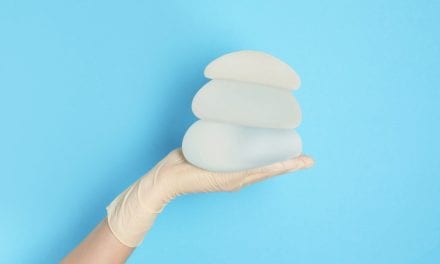A continuous evolution
 This is a summary insight into the alloplastic implants currently used in cosmetic, plastic, and reconstructive therapies. Along with the continuous evolution of clinical techniques and implant technological improvements, the status of available products and procedures will change.
This is a summary insight into the alloplastic implants currently used in cosmetic, plastic, and reconstructive therapies. Along with the continuous evolution of clinical techniques and implant technological improvements, the status of available products and procedures will change.
Breast (Mammary) Implants
The most widely used body-contouring implants are breast or mammary implants, which are available worldwide and offered as saline-filled, silicone gel-filled, or a combination (double-lumen). According to physicians, important factors in implant selection are:
• tissue-like feel & variety of sizes;
• lack of complication/long term safety (no contracture);
• ease of placement/removal; and
• good service from the supplier & cost (return policy, replacement insurance).
Based on increased FDA scrutiny and public awareness, safety issues include:
• biocompatibility of breast implant filler material;
• capsular contracture (estimates range from 10%–70% incidence);
• polyurethane’s potential link to cancer (noted in a widely publicized study);
• silicone granulomas (which are hard to distinguish from cancerous lumps);
• rupture of implant with silicone spill (estimated between 7–43%);
• changes in nipple and breast sensation;
• possible interference with breast feeding;
• possible cancer risk;
• possible connective tissue disorders;
• registry and tracking of implants; and
• sychological impact on the patient as a measure of efficacy.
Interference with mammography is perhaps the biggest issue, with breast cancer the second most common cancer affecting women. The ability to maintain the effectiveness of mammography while providing the freedom to have a breast implant is a critical consideration. Manufacturers must address these issues before expecting consumers or physicians to adopt their implants.
Silicone Gel-Filled Breast Implants
Breast-implant technology has evolved slowly since the advent of the silicone gel implant by Cronin in the early 1960s. Historically, breast implants consisted of a silicone rubber shell and a filler material comprised of silicone gel (polymerized silicone matrix combined with low viscosity silicone fluid), physiologic saline, and sometimes both (double lumen implants).
Silicone gel implant fillers were altered to minimize problematic outcomes, such as palpability and capsular contracture. As a result, during the 1970s the shell became thinner to improve palpability and the gel became less viscous (more responsive) in an unfortunate attempt to reduce capsular contracture. The design changes from the 1970s were reversed in the 1980s due to problems and complications created by these changes. The silicone gel became more viscous (cohesive) and the shell became thicker again, utilizing new material technologies to minimize ruptures and bleed (diffusion) of small quantities of the lower-molecular-weight silicone gel components. From the 1980s to the present, shell modifications have focused on altering the process of scar formation, scar thickening, and tightening around the implant (capsular contracture), rendering the breast abnormally firm, or round, difficult to analyze with mammography, and sometimes tender and painful.
Current Regulations

In 1991, amid great controversy, FDA Panel hearings evaluated data submitted by manufacturers, notably McGhan Medical (Inamed Aesthetics), Mentor Corp. and Dow Corning. Surgitek, a subsidiary of Bristol-Myers, folded its operations prior to the hearings due to the controversy over its previously withdrawn polyurethane-coated breast implant. As a result of conflicting Panel recommendations and significant political pressure, in January 1992 the FDA Commissioner determined a moratorium be placed on the sale and use of silicone gel-filled implants pending further data review. The following month, another FDA Panel reviewed previous findings to assess new data and severely restricted the use of silicone gel-filled breast implants, subjecting them to stringent investigational protocols.
In April, the FDA announced that silicone gel-filled breast implants would be available in the United States only under the auspices of a clinical trial. Several categories of patients were described and, in effect, women undergoing reconstruction after mastectomy were separated from women who desired breast enhancement alone. These groups were subjected to different criteria under new clinical trial protocols.
Recent FDA Changes

Additionally, prospective clinical trial data presented by McGhan and Mentor during their successful PMA Panel meetings in March 2000 answered a number of interim concerns and was positioned to answer long-term issues as well. In fall 2003, an FDA Expert Advisory Panel voted to give commercial sales approval to one manufacturer of a silicone gel-filled implant; but due to ongoing controversy, the recommendation was placed “on hold” pending further review. Then, the FDA issued a “not approvable notice” to that company. A new FDA Expert Advisory Panel is scheduled to meet in April 2005 to review silicone gel implant data available from sources and manufacturers.
Saline-Filled Breast Implants

The basic design of saline-filled breast implants has changed little in the last 10 to 20 years. New manufacturing materials, along with improved surgical techniques, have reduced complications such as deflation, valve leakage, bond delamination, and capsular contracture. Saline-filled breast implants were classified during the 1990s, and two manufacturers received conditional approval for ongoing commercial distribution in 2001. It is anticipated that two to four new manufacturers of saline-filled breast implants will have commercial approval before the decade is over; and that when gel-filled breast implants finally get approval, they will recapture approximately 50% to 60% of the market share.

Studies have been published from scientists with concerns about the deposition of significant quantities of PVP in the subcutaneous tissue plane. According to one industry expert, PVP (used as a plasma expander) may be stored in the body, but it may be toxic to certain organs in high concentration. Although it is safe to swallow as an encapsulant for pharmaceuticals, it may be unsafe when implanted. hyaluronic acid may be the best of these hydrogels, but it faces an almost insurmountable barrier due to cost.
Other Body-Contouring Implants

Consumers are inundated with information on implants, and demand has increased accordingly. An example is the buttock or gluteal implant procedure, which increased 300% in each of the last 2 years and is expected to increase further as surgeons become acquainted with the procedure and complications are reduced.
Facial Implants
Facial implants are divided into basic facial feature areas such as the chin, cheek (malar), and nose. As with body-contouring implants, these are primarily made from implant-grade, soft solid silicone or porous polyethylene in the United States. Outside the United States, silicone gel-filled implants are available for selected products. The majority of surgeons use silicone implants; however, some physicians prefer the porous polyethylene implants for bone on-lay applications that require incorporation into the bone matrix for efficacy. Significant changes in materials and product design are not anticipated in the near term. For the longer term, patient-specific implants, based on individual radiology test data such as MRI and PET, will be more common as costs are reduced.
Finger Joints
The Swanson-style silicone finger joint remains the principal option available from several manufacturers, but the availability of devices for small joints remains elusive. Formal clinical trials for these devices in the United States are not under way at this time. When available, these will fill a significant void in the hand surgeon’s armamentarium.
Scientists are evaluating the ability to harvest fat cells from individuals and grow breasts on a resorbable matrix to create a living replacement breast, as well as the ability to grow patient-specific replacement “parts,” such as ears from stem cells harvested from individuals. While these are exciting, they aren’t expected in the marketplace anytime soon.





